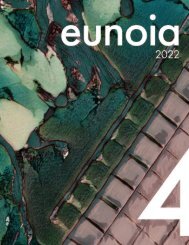WSU EUNOIA Volume III
You also want an ePaper? Increase the reach of your titles
YUMPU automatically turns print PDFs into web optimized ePapers that Google loves.
The aeroponic farm towers provide
pollen as a food source while also
producing food for the urban population.
The HAAP is, therefore, able to act
as a hub from which pollinators can
venture out to benefit green spaces
and increase ecological biodiversity
through pollination. Programmatically,
the HAAP also integrates a market,
café, and education center focused
on nutrition and dietary education, as
well as the critical role of pollinators
in food production. The structure of
the building is meant to optimize farm
space while remaining minimal and
open to allow flying pollinators to pass
through the rows of plantings while the
Operable ETFE facade can be closed
during inclement weather. The dense,
750,000 ft 3 aeroponic farm generates
as much fresh produce as nearly 500
acres of traditional farm land while
reducing water consumption by 97%.
The HAAP’s urban farm and restorative
habitat will protect and encourage
pollinator populations and has the ability
to become a model for alternatives to
mono-cultures.
HAAP
NATE KIRK
GRADUATE ARCH STUDIO | SPRING 2021
The Hub for Agriculture and Anthropology of Portland, HAAP, is designed as an
urban farm and restorative habitat for pollinator species. Large-scale mono-culture
agriculture is one of the main threats to pollinator species, destroying large areas of
habitat with low-nutrition and low-pollen mega crops, such as wheat, soy, and corn.
The HAAP won a Citation Award for its efforts in the 2021 AIA Northwest and
Pacific Region Student Design Awards.
The HAAP is envisioned as an alternative
to mono-culture agriculture by providing
compact, high-yield farming in an urban
context, serving as a prototype and
precedent that could be replicated in any
large city. The project site is located in
the urban core of Portland, Oregon. The
design of the site is tailored specifically
to the needs and requirements of native
pollinator species, while much of the
architectural program is designed to
be below grade, maximizing native
habitation and vegetation for the
pollinators.
Studio led by Paul Hirzel
26 27
volume iii
eunoia





